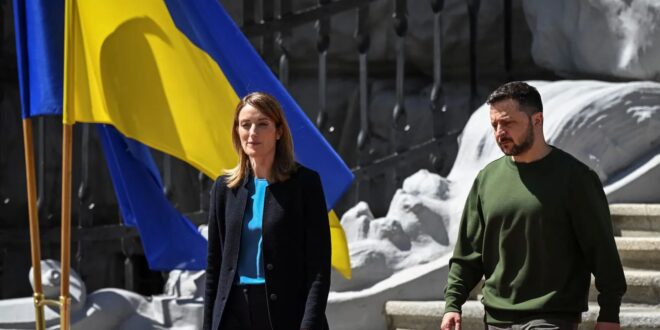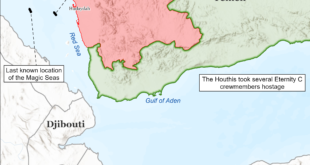How to Expand Europe Without Destabilizing It
Faced with the threat posed by Russia after its full-scale invasion of Ukraine, the European Union has launched a new enlargement process that is more ambitious and complex than any it has ever undertaken. Ukraine is the most prominent of the new candidate countries, but the list includes Moldova, Georgia, and much of the western Balkans. And the European institutions—meaning the European Council, the Council of the European Union, and the European Parliament—are pushing hard to make sure there is credible progress to underpin both security and stability on the EU’s eastern and southeastern borders. But the EU cannot afford to repeat the experience of the western Balkans, where for the last two decades governments have pretended to reform while the European Union has pretended to want them to gain entry.
The problem for the EU is that its enlargement strategy may weaken or even undermine the democratic stability it seeks to preserve. Joining the EU goes far beyond the incorporation of tens of thousands of pages of European legislation into the national laws of candidate countries. It also includes a reengineering of their political institutions, market structures, and relations with third countries. This process necessarily requires a restructuring of the country’s firms and industries that will create both winners and losers on a massive scale.
Within this adjustment process, the EU needs to help national governments find ways to ensure that enough voters and politicians in each of the candidate countries buy into the new system to prevent one group or another from trying to capture the state and any European support that comes with it. The integration strategy should consider to a much larger degree the economic and political consequences of meeting the accession criteria. Building a strong democratic coalition takes time. Europe needs to accept new members quickly to secure democracy today, but it needs to bring them in slowly to secure democracy and stability in the future.
EASTWARD EXPANSION
In December, the European Council, which is made up of representatives from the 27 countries in the union, announced that it would soon open accession negotiations with Ukraine, Moldova, and eventually Georgia, alongside similar talks with the countries of the western Balkans, including Bosnia and Herzegovina. The sense of urgency comes from today’s security environment. Russia’s invasion of Ukraine has made it imperative that the EU stabilize its eastern and southeastern frontiers.
This is not the first time that security threats have pushed the EU to take on new members quickly. The admission process for the countries of central and eastern Europe accelerated sharply after the NATO bombing of Kosovo and Serbia in 1999, as European leaders recognized that the attractions of EU membership could help shore up political stability within the countries on the EU’s frontier. Afterward, what was originally intended to be a slow, methodical, and transformative process involving a limited number of countries turned into a race to offer membership to as many countries as possible.
From that experience, it became clear that any round of EU enlargement requires striking a delicate balance. The EU needs to extend a credible offer of membership to get the accession countries to do what is necessary to join: strengthen their economies, reinforce democratic institutions, and safeguard the rule of law. But often the urgency behind bringing the new members on board means that the whole process moves faster than the transformation of the countries involved—as well as the EU’s own ability to integrate them.
The EU cannot afford to repeat the experience of the western Balkans.
The results from Europe’s enlargement to the countries of central and eastern Europe in the first decade of this century were mixed. Europe’s leaders managed to bring in more countries than they initially expected. But they also failed to spot important problems. They failed to recognize the political polarization and progressive state capture that was already developing in Hungary and Poland, and they failed to push hard enough for reforms in Bulgaria and Romania. The outcome was better than the alternative of having unstable governments on EU’s borders that could dissolve in civil strife or even conflict with one another. Nevertheless, the rapid accession of new members sidestepped many problems that later came back to haunt European politicians.
Support for the institutional reforms necessary to accommodate a larger number of member states waned both within the European Council and among the public. European leaders were able to agree on a “constitutional treaty,” designed to bring the institutions of the EU closer to the people, only to see that agreement collapse in popular referendums in France and the Netherlands. In the Lisbon Treaty of 2009, EU members managed to embrace many of the reforms they needed to undertake, but only by avoiding letting the public weigh in.
The legacy of that historic enlargement was a mixture of frustration and fatigue. What followed was a serious fight over democratic backsliding, a loss of enthusiasm for enlargement more generally, and the United Kingdom’s decision to leave the EU in 2016. Croatia managed to join in 2013, but the rest of the western Balkans made little if any progress toward membership and Turkey remained a candidate in name only. The global financial crisis of 2008 introduced new cleavages both between creditor countries in the north and borrowers in the south, and between Western governments that worried about preserving their welfare states and Eastern European governments that still had to complete the painful transition to a well-functioning market economy with a full range of public services. Europeans like to claim that their union was forged in crisis, but crisis management tends to suck the oxygen away from other efforts—including the plodding work of undertaking institutional reforms that must accompany enlargement.
KEEPING THE WOLVES AT BAY
The EU’s previous experience with enlargement is important because this next round will be even harder. Unlike the last round, this one will not be preceded by NATO enlargement, which means the EU will have to take on more responsibility for security than it usually does. Any attempt at enlarging the EU must be seen as credible in the candidate countries, but it also has to underwrite the credibility of bilateral and multilateral security guarantees in the eyes of Moscow. The more deeply Ukraine (or any candidate country) is integrated into the European economy, the more the EU and its member states have an interest in pushing back against Russian aggression. If Ukraine eventually signs a cease-fire with Russia, the EU’s assurances to protect Kyiv will help to serve as a deterrent to any future Russian attack.
The security context is different in other ways, too. The challenge the EU faced after the Cold War was to stave off internal threats to democratic stability. Slovak Prime Minister Vladimir Meciar, who threatened to hijack his country’s democratic ambitions by capturing state institutions, ranked high among the villains of the day; Corneliu Vadim Tudor, a Romanian party leader, raised an even more disturbing prospect of using violence against minorities if he should ever gain high office. Today, the threats to would-be EU members are more external than internal—and Russian President Vladimir Putin is the greatest source of concern. The worry is not only that Russia will continue its war against Ukraine but also that it will seek to destabilize other countries on the border of the EU through either violence or further disinformation campaigns.
The EU must make clear to the Russians that any destabilization of Europe’s borders will be met with a disproportionate response—something along the lines of French President Emmanuel Macron’s repeated threat to put French troops in Ukraine. The goal is not escalation but deterrence. Third countries—meaning Russia in military terms but also China in terms of political interference—need to know that Europe is serious about stabilizing the countries on its borders. Those countries seeking to join the EU need to know this as well. The internal threats that challenged the EU in its first eastern enlargement have not vanished; they are just less urgent than the threats from Russia and elsewhere. By implication, this new enlargement process needs to be credible in two senses of the term: the candidates need to believe that they will become member states while Russia and China need to believe that the European Union will protect its members.
To be credible in the eyes of the Russians as well as the Ukrainians, the EU’s latest round of enlargement will have to move at an even faster pace than before. On the economic front, the EU can forge special bilateral agreements with prospective members—as it has already done with the Deep and Comprehensive Free Trade Agreement with Ukraine, a deal that Ukraine initially rejected in 2013, in response to Russian pressure, but has since accepted. Further integration of Ukraine into the EU can happen in stages, whereby it and other candidate countries are brought into EU legislative processes as observers on a piecemeal basis long before the necessary domestic institutional reforms are in place. This approach would not only send a powerful signal that these countries will one day become members but also give their civil servants exposure to how the European Union works.
BUILDING THE BULWARK
This vision for Europe is less about winning the war than it is about winning the peace—or whatever cessation of hostilities that can be managed between Russia and Ukraine. The prospect of an outright victory for Ukraine, one that Russia accepts, is difficult to imagine. Any outcome short of that will rely heavily on a mix of deterrence and development inside Ukraine to keep Russia from attacking again.
Europe will have to win the peace by using the processes of postwar reconstruction and EU integration to strengthen Ukraine’s democracy and economy. Since the creation of independent Ukraine in 1991, any sign of weakness in Ukrainian governance or development has been used by Moscow to destabilize the country. If Ukraine emerges as an unstable democracy with an unstable economy, it would be a defeat for Europe and a threat to its security. A democratic and economically successful Ukraine can provide a model for Russia’s own development someday, and it might further weaken Moscow’s attempts at creating a political and military alliance of former Soviet republics under Moscow’s control.
To win the peace, the biggest challenge will be to ensure that the enlargement process moves quickly enough to be credible and slowly enough for the candidate countries to manage the huge costs of adjustment. The resources promised for postwar reconstruction in Ukraine can serve the role that the Marshall Plan played after World War II in countering Moscow’s expansionary plans. The problem is that the EU integration strategy, at its present pace and with the existing requirements for reforming political and economic institutions, might weaken the chances of security and destabilize the EU’s eastern frontier by creating more losers than winners in economic terms. If the accession process prevents the Ukrainian government from building a strong coalition in support of the adjustments required for EU membership, it might endanger building stable democracy and rule of law in Ukraine, reduce the chances of setting the Ukrainian economy on a sustainable path for development, and so ultimately prove self-defeating.
The EU’s integration strategy is primarily an externally directed process that includes the implementation of nearly 100,000 pages of political and economic rules and norms. It distinguishes between the conditions deemed necessary for the stability of the political institutions and the implementation of the economic rules of the EU. The assumption is that the desire to become a member of the richest club in the world is what will guarantee lasting compliance with the EU’s rules.
The threats to would-be EU members are more external than internal.
Behind the EU’s approach to integration is the idea that democracy and the rule of law, once in place, are self-perpetuating and largely independent of their social and economic environment. Alas, as recent experience has shown, they are not. Instead, those institutions are prone to capture. Hungary is probably the best illustration, given the way Viktor Orban used his supermajority in parliament to rewrite the constitution. The Law and Justice Party in Poland could not rewrite the constitution, but it took over the judiciary and undermined the freedom of the press. At best, liberal democratic institutions become sustainable and work in the desired way if political, economic, and social power is dispersed and no powerful group has the capacity to manipulate the political institutions and set the rules of the game unilaterally.
The stability of democratic institutions and the rule of law also relies on the existence of a diversity of social groups that stand to gain from the proper functioning of these institutions and have the capacity to defend these institutions if they are being threatened. The EU has recognized the importance of the first condition—preventing extreme power concentration—and it now demands that countries enact measures that disperse political and economic power, reducing the political power of economic oligarchs or decentralizing political authority to regional or local institutions.
The European institutions need to take further steps, however, especially to protect EU fiscal transfers from being misused to concentrate power inside the country. The EU budget includes important structural and cohesion funds to support the economic development of poorer regions across the European Union. Those funds are distributed to national governments and not regional authorities. As a result, in several of the candidate countries, central governments could use their ability to distribute billions of euros to concentrate economic and political power—to punish firms that dared to support the political opposition and to make loyalty to incumbent politicians the key to accessing EU resources for nongovernmental organizations and municipalities.
The EU integration strategy focuses on building a country’s capacity to play by the EU’s economic rules, but it largely disregards the conditions needed to live by these rules. Several of the EU’s rules might improve the working of the Ukrainian economy. But without public intervention to support workers and firms during the transition period, whole sectors and geographic areas might get marginalized or completely excluded from the market. This exclusion creates fertile ground for economic nationalism, authoritarian populism, and Euroskepticism, as seen not just in the rural communities of Hungary and Poland but also in Slovakia, Bulgaria, Romania, and many older member states in Western Europe.
HOW TO LOSE THE PEACE
During the previous wave of enlargement, the EU experimented on a small scale with various strategies for managing such problems, letting some of the inefficient sectors and firms fail and implementing programs for upgrading others. Although these experiments have helped keep these economies afloat up until accession, the fact that domestic political actors have played only a marginal role in these programs creates openings for populist political forces to politicize the negative social and economic consequences of integration. Ask Czech citizens why their country is prosperous, they will point to their own hard work and determination; ask them what is holding them back, they point to the European Union.
If the EU does not want to see the rise of illiberal demagogues in Ukraine, it will have to find ways to help create broad-based domestic coalitions in support of the adjustments necessary to join the European Union and the democratic institutions that will be in place once Ukraine becomes a member state. Not doing so would give Moscow the opportunity to promote those groups that lose out from the adjustment process to destabilize Ukraine. This has been a clear part of Russia’s playbook in supporting right-wing extremist parties across the EU; they can only be expected to redouble their efforts in new candidate countries. Spending postwar reconstruction funds in a way that ensures a wide distribution of winners would be the best investment the EU could make for European security.
The simultaneous challenges of security and democratic safeguarding have never been more difficult in Europe than they will be in the next round of enlargement. Nevertheless, a quick enlargement to create security and a slower pace of adjustment to ensure broad-based pro-democracy coalitions are in place must go together. Strategies of deterrence on their own might be useless if they are not combined with strong domestic alliances in the new member states supporting EU political and economic institutions. The alternative is to lose the peace and waste years of effort in Ukraine and elsewhere that, in the end, will merely give Moscow time to prepare for the next round of war.
 Eurasia Press & News
Eurasia Press & News


